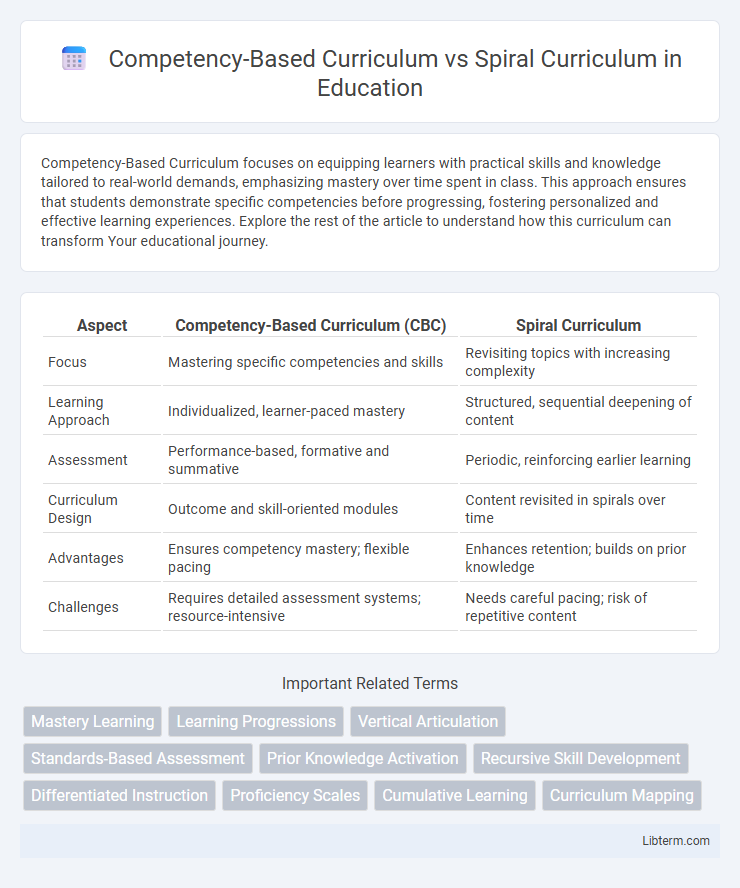Competency-Based Curriculum focuses on equipping learners with practical skills and knowledge tailored to real-world demands, emphasizing mastery over time spent in class. This approach ensures that students demonstrate specific competencies before progressing, fostering personalized and effective learning experiences. Explore the rest of the article to understand how this curriculum can transform Your educational journey.
Table of Comparison
| Aspect | Competency-Based Curriculum (CBC) | Spiral Curriculum |
|---|---|---|
| Focus | Mastering specific competencies and skills | Revisiting topics with increasing complexity |
| Learning Approach | Individualized, learner-paced mastery | Structured, sequential deepening of content |
| Assessment | Performance-based, formative and summative | Periodic, reinforcing earlier learning |
| Curriculum Design | Outcome and skill-oriented modules | Content revisited in spirals over time |
| Advantages | Ensures competency mastery; flexible pacing | Enhances retention; builds on prior knowledge |
| Challenges | Requires detailed assessment systems; resource-intensive | Needs careful pacing; risk of repetitive content |
Introduction to Curriculum Design Approaches
Competency-Based Curriculum emphasizes mastery of specific skills and knowledge through measurable learning outcomes, ensuring learners achieve predefined competencies before progressing. Spiral Curriculum revisits key concepts repeatedly with increasing complexity, reinforcing understanding and promoting long-term retention across educational stages. Both approaches offer distinct frameworks in curriculum design, targeting effective knowledge acquisition and learner development.
What is a Competency-Based Curriculum?
A Competency-Based Curriculum (CBC) emphasizes mastery of specific skills and knowledge, allowing students to progress upon demonstrating proficiency rather than time spent in class. This model prioritizes individual learning outcomes and real-world application, ensuring learners achieve defined competencies essential for academic and career success. Unlike traditional curricula, CBC provides personalized pacing and continuous assessment to support skill development tailored to student needs.
Core Principles of Competency-Based Learning
Competency-Based Curriculum emphasizes mastery of specific skills and knowledge through personalized pacing, clear learning outcomes, and continuous assessment to ensure students achieve proficiency before advancing. This approach prioritizes student-centered learning, allowing learners to demonstrate competency through practical application and real-world tasks. In contrast, Spiral Curriculum revisits core concepts at increasing levels of complexity without necessarily focusing on individual mastery at each stage.
What is a Spiral Curriculum?
A Spiral Curriculum revisits key concepts repeatedly over time, gradually increasing in complexity and reinforcing previous knowledge to deepen understanding and retention. This approach contrasts with Competency-Based Curriculum, which focuses on mastering specific skills or competencies before progressing. Spiral Curriculum promotes cumulative learning by intertwining new content with prior lessons, facilitating continuous cognitive development and skill reinforcement.
Key Features of Spiral Curriculum Models
Spiral curriculum models emphasize revisiting core concepts repeatedly over time with increasing complexity, ensuring deeper understanding and retention. Key features include progressive reinforcement, thematic integration, and one concept's foundation serving as a scaffold for future learning. This approach contrasts with competency-based curricula, which focus on mastering discrete skills or competencies before advancing.
Comparative Analysis: Competency-Based vs Spiral Curriculum
Competency-Based Curriculum emphasizes mastery of specific skills and knowledge at an individual pace, ensuring learners achieve predefined competencies before progressing. Spiral Curriculum revisits key concepts repeatedly over time, increasing complexity with each exposure to reinforce understanding and retention. The primary distinction lies in Competency-Based Curriculum's focus on skill acquisition and individual progression, while Spiral Curriculum prioritizes cumulative reinforcement through iterative learning cycles.
Student Assessment in Both Curriculum Types
Competency-Based Curriculum emphasizes student assessment through mastery of specific skills and knowledge, allowing personalized pacing and continuous feedback to ensure proficiency before progression. Spiral Curriculum integrates student assessment by revisiting core concepts periodically with increasing complexity, promoting cumulative understanding and skill reinforcement over time. Both approaches use formative and summative assessments but differ in pacing and the structure of evaluating student learning outcomes.
Benefits and Challenges of Competency-Based Curriculum
Competency-Based Curriculum (CBC) emphasizes mastery of specific skills and knowledge, allowing students to progress at their own pace, which enhances personalized learning and ensures practical proficiency. It promotes clear learning outcomes and accountability but faces challenges such as extensive resource requirements, the need for continuous assessment, and difficulty in standardizing progress across diverse learners. Compared to Spiral Curriculum, which revisits topics periodically to deepen understanding, CBC demands rigorous curriculum design and teacher training to effectively implement competency assessments and support individualized instruction.
Advantages and Limitations of Spiral Curriculum
The Spiral Curriculum enables learners to revisit key concepts repeatedly with increasing complexity, reinforcing long-term retention and deeper understanding. Its limitation lies in the potential for cognitive overload if topics are not carefully sequenced, which can hinder mastery of fundamental skills. Effective implementation requires precise curriculum design to balance content repetition and progressive difficulty, ensuring optimal student engagement and academic growth.
Choosing the Right Curriculum for Effective Learning
Competency-Based Curriculum emphasizes mastery of specific skills and knowledge at the learner's pace, ensuring personalized progress and practical application. Spiral Curriculum revisits key concepts regularly with increasing complexity, reinforcing understanding and promoting long-term retention. Choosing the right curriculum depends on the learners' needs: Competency-Based suits individualized learning paths, while Spiral Curriculum benefits those requiring cumulative reinforcement and deeper conceptual connections.
Competency-Based Curriculum Infographic

 libterm.com
libterm.com